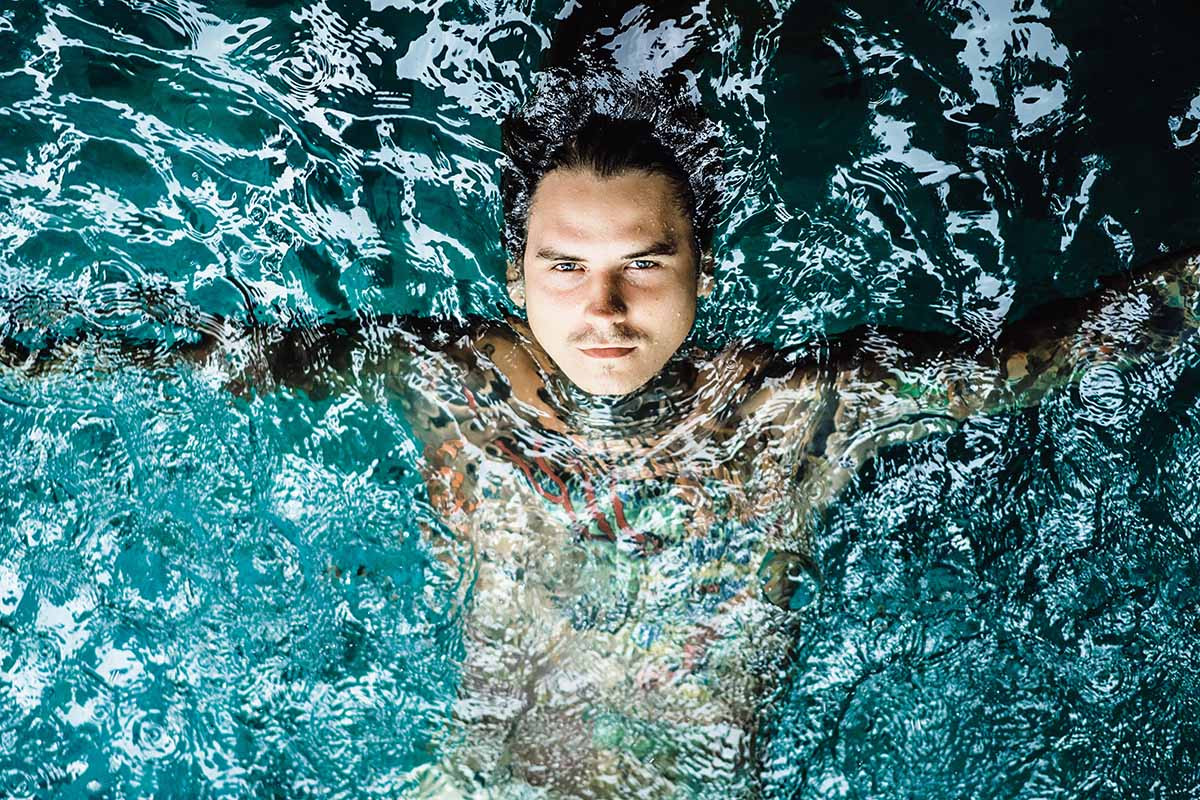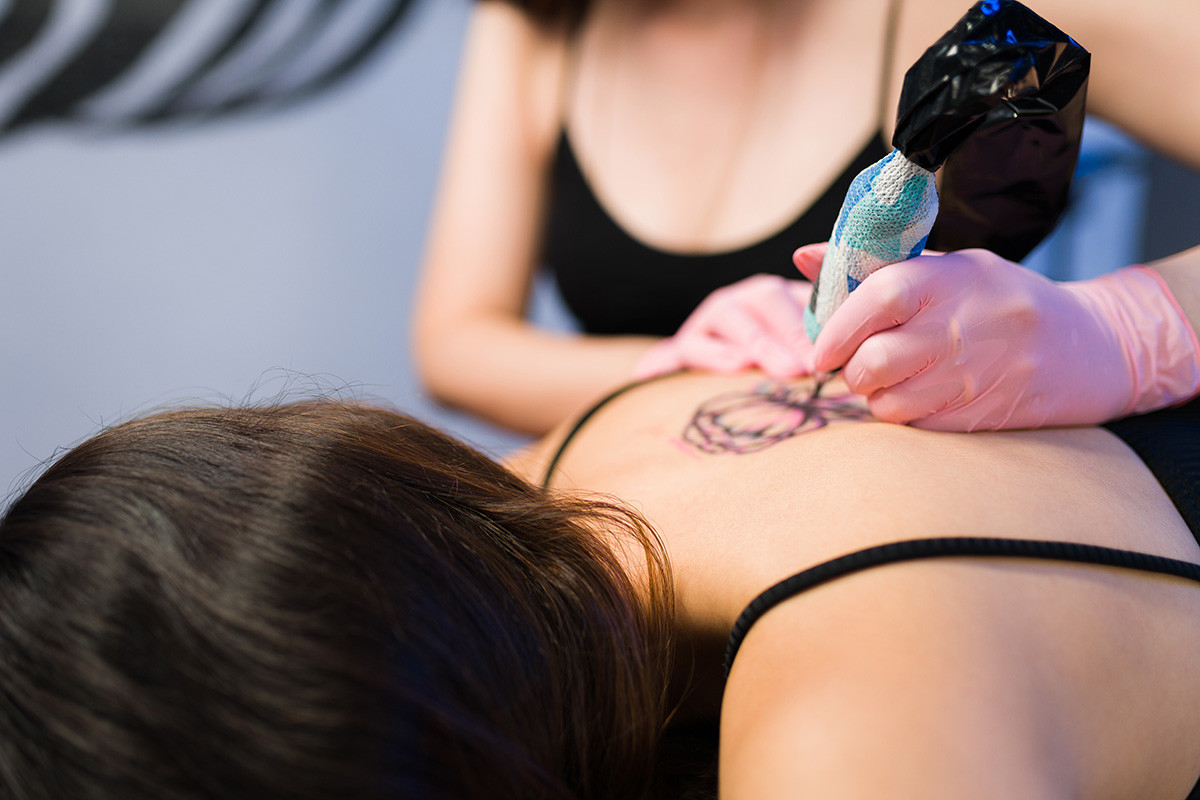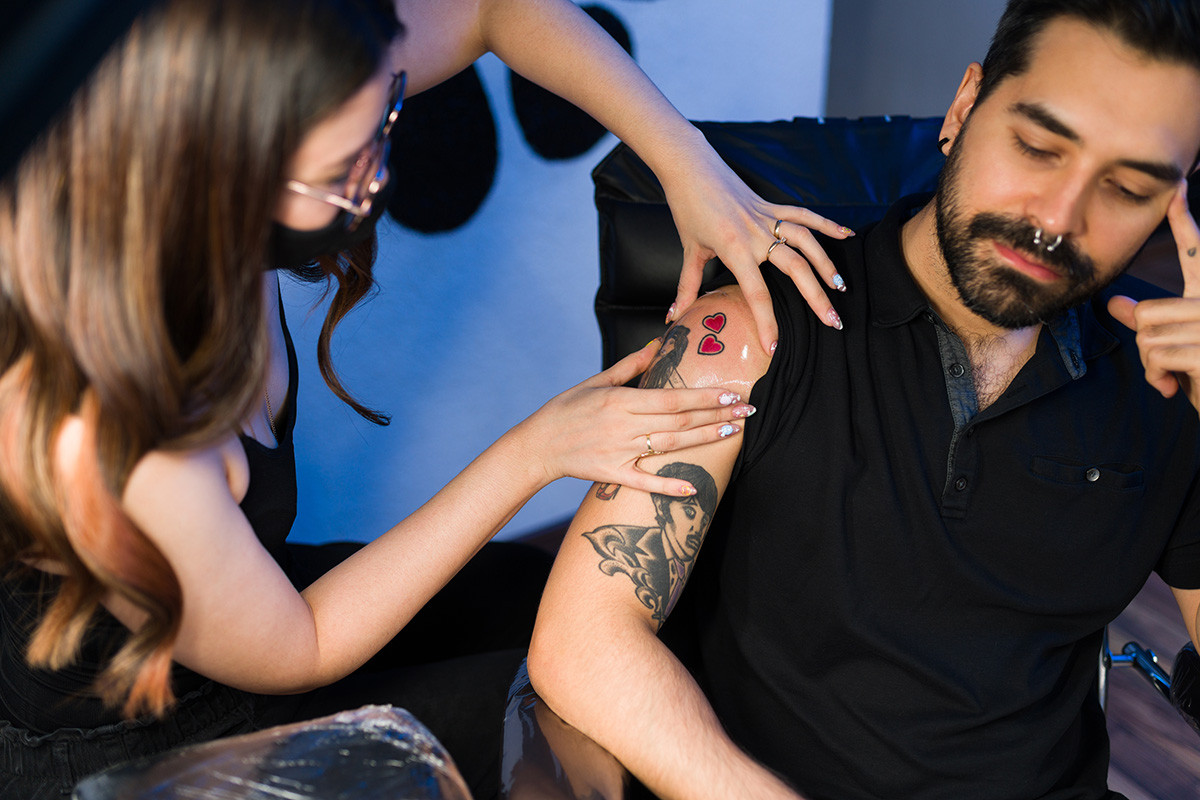Thinking about showing off your fresh ink at the pool? How Long Does A Tattoo Take To Heal Before Swimming? Generally, you should wait 2-4 weeks before swimming to avoid infection and ensure proper healing; Tattoo aftercare is critical for vibrant, long-lasting body art. At tattooat.com, we provide expert guidance on tattoo healing, aftercare products, and connecting with talented tattoo artists to help you make informed decisions about your tattoo journey. Dive in to learn more about tattoo healing timelines, potential risks, and tips for protecting your new skin art.
1. Understanding Tattoo Healing and When You Can Dive Back In
 A person getting a new tattoo and the healing process
A person getting a new tattoo and the healing process
When can you dive back in after getting a tattoo? Typically, tattoo artists recommend waiting at least 2 to 4 weeks before submerging your new tattoo in swimming pools, hot tubs, or open water. This timeframe allows the skin to heal properly, minimizing the risk of infection and ensuring the longevity of your tattoo design.
The tattoo healing process is crucial for preserving both the health and appearance of your new body art. A new tattoo is essentially an open wound, making it vulnerable to bacterial infections and skin irritation if exposed to water too soon. Factors such as the size and location of the tattoo, individual skin type, and the quality of aftercare all play a role in healing time. It’s essential to understand the stages of tattoo healing and how these factors influence the overall process. According to Inked Magazine, proper hydration and a healthy lifestyle can significantly boost your body’s natural healing abilities, leading to a quicker recovery.
2. What Are The Stages of Tattoo Healing?
What are the stages of tattoo healing? The typical healing process includes initial swelling, pain, and oozing, followed by itching, peeling, and ongoing aftercare. Full healing can take anywhere from 2 to 4 weeks, or even up to 6 months for some individuals.
During this period, it’s best to avoid swimming and other activities that can irritate the skin and prolong the healing process. Open water, in particular, poses the greatest risk of bacterial infection. Infections can not only delay healing but also damage your tattoo’s appearance. Patience is key to ensuring your tattoo heals properly and looks its best. Tattooat.com offers resources and tips to guide you through each stage of the healing process, ensuring your tattoo remains vibrant and infection-free.
3. What Factors Affect Tattoo Healing Time?
Several factors can affect how long a tattoo takes to heal. These include:
- Size of the Tattoo: Larger tattoos naturally require more time to heal due to the increased area of traumatized skin.
- Location of the Tattoo: Areas of the body with higher friction or movement, such as joints, may take longer to heal.
- Aftercare: Proper aftercare, including regular cleaning and moisturizing, is crucial for reducing healing time.
- Skin Type: Individual skin types can vary in healing time, with some skin types healing more quickly than others.
- Overall Health: Your general health and immune system strength play a significant role in how quickly your body can heal.
It’s essential to monitor the healing process closely and consult your tattoo artist or a medical professional if you have any concerns about your tattoo’s healing progress.
4. Can Swimming With A Fresh Tattoo Be Risky?
Yes, swimming with a fresh tattoo can expose your new body art to several potential issues. Water exposure can dry out the skin, leading to increased itching, flaking, and scabbing. This can compromise the tattoo’s appearance, causing fading, patchiness, and blurred lines.
Beyond physical discomfort and potential damage, swimming with a fresh tattoo also increases the risk of bacterial infections. Pools, lakes, and oceans harbor bacteria that can easily invade an open wound like a healing tattoo. To protect your tattoo and ensure a smooth healing process, it’s best to avoid swimming until it is fully healed. Tattooat.com provides detailed articles on avoiding tattoo complications and understanding the importance of professional aftercare.
5. How Do Bacterial Infections Affect Open Wounds Like New Tattoos?
Tattoos involve breaking the skin and introducing a foreign substance (ink) into the body, which classifies them as open wounds. Submerging a healing tattoo in water exposes it to harmful bacteria in pools, lakes, and oceans, leading to irritation, infection, and other complications that can harm the tattoo and prolong the healing process.
To minimize the risk of bacterial infections, keeping your new tattoo clean and protected from water exposure is vital. Waterproof dressings and bandages can shield your tattoo from bacteria and other contaminants while swimming. Always err on the side of caution when it comes to your tattoo’s health.
6. What Are The Effects of Chlorine and Salt Water on New Tattoos?
Chlorine and salt water can have detrimental effects on a fresh tattoo. Exposure to these elements can cause:
- Irritation
- Fading
- Discoloration
- Leaching of Ink
Even in a chlorinated pool, chlorine doesn’t eliminate all bacteria and still poses a risk to your healing tattoo. Furthermore, both chlorine and salt water can dry out the skin, exacerbating irritation and prolonging the healing process. To ensure proper healing and maintain the tattoo’s vibrant appearance, avoiding swimming until the tattoo is fully healed is best. Tattooat.com provides resources on aftercare products specifically designed to protect tattoos from chlorine and salt water.
7. What Steps Can You Take to Protect Your New Tattoo While Swimming?
 A person protecting their new tattoo while swimming with waterproof dressings and bandages
A person protecting their new tattoo while swimming with waterproof dressings and bandages
If you absolutely must swim before your tattoo is fully healed, you can take precautions to protect your new ink. Using waterproof dressings and bandages can shield your tattoo from water and bacteria while swimming. However, remove the dressing immediately after swimming and thoroughly clean your tattoo to minimize the risk of infection.
Swimming with a fresh tattoo is not recommended, and these precautions do not guarantee complete protection from infection or damage. Waiting until your tattoo is fully healed before submerging it in water is always best, but if you must swim, take the necessary steps to protect your body art.
8. Which Waterproof Dressings and Bandages Are Recommended for New Tattoos?
Waterproof dressings and bandages can be crucial if you need to swim with a new tattoo. These coverings create a barrier between your tattoo and the water, helping protect your new ink from bacteria and contaminants.
Some recommended waterproof dressings include:
- Saniderm Tattoo Aftercare Bandage
- Recovery Derm Shield Tattoo Aftercare Bandage
- Tattoo Aftercare Waterproof Bandage
- Nexcare Tattoo Bandages
- Nuanchu Waterproof Bandage
Apply the dressing before swimming, remove it immediately afterward, and change it regularly to ensure your tattoo remains protected.
9. What Does Effective Post-Swim Tattoo Care Involve?
After swimming, cleaning and caring for your tattoo is vital to minimize the risk of infection and damage. Follow these steps:
- Gently wash the tattoo with warm water and mild, fragrance-free soap.
- Pat the area dry with a clean towel.
- Apply a thin layer of fragrance-free moisturizer to keep the skin hydrated and promote healing.
Post-swim care is crucial for maintaining the health and appearance of your tattoo. Taking the necessary steps to protect your new ink ensures a smooth healing process, allowing you to enjoy your beautiful tattoo for years. Tattooat.com offers a curated selection of aftercare products designed to soothe and protect your skin, promoting faster healing.
10. How Can You Tell When Your Tattoo Is Ready for Swimming?
How can you tell when your tattoo has healed and is safe for swimming? Key signs include the absence of redness, itching, scabbing, or flaking, as well as a smooth, even appearance without any peeling.
If you’re unsure whether your tattoo is fully healed, consult your tattoo artist or a medical professional before swimming. They can assess your tattoo’s healing progress and provide expert guidance.
11. What Visual Indicators Suggest a Tattoo Is Ready for Swimming?
Visual indicators can help you determine if your tattoo is ready for water exposure. Look for these signs:
- No bubbling or degradation
- No redness or peeling
- A smooth, even appearance without flaking or scabbing
If your tattoo meets these criteria, it’s likely healed and safe to expose to water. Remember that everyone’s healing process varies, so monitor your tattoo closely. Contact your tattoo artist or a medical professional if you have any concerns or unusual symptoms.
12. Why Is Consulting Your Tattoo Artist Important Before Swimming?
Your tattoo artist is an invaluable resource for determining if your tattoo is ready for swimming. They have extensive experience with the healing process and can assess your tattoo’s progress, providing expert guidance.
If you’re unsure whether your tattoo is fully healed, visit the studio where you got the tattoo and have a professional check it. It’s always best to err on the side of caution and ensure your tattoo is fully healed before swimming. Tattooat.com lists reputable artists in the Portland area who can provide personalized aftercare advice.
13. What Are Alternative Water Activities During the Tattoo Healing Period?
 A person enjoying alternative water activities during the tattoo healing period
A person enjoying alternative water activities during the tattoo healing period
If you’re eager to get in the water while your tattoo is healing, alternative water activities can help you stay clean without risking damage to your new ink. Instead of swimming, consider taking gentle showers and avoiding direct water jets. You can also boil tap water for cleansing to minimize the risk of infection.
Keeping your new tattoo clean and protected from water exposure during the healing process is essential. Alternative water activities allow you to enjoy the water while ensuring your tattoo heals properly.
14. Why Should You Avoid Hot Tubs, Saunas, and Other Water Hazards After Getting a Tattoo?
Hot tubs and saunas can pose significant risks to your new tattoo if you indulge too soon after getting inked. The warm, moist environment increases the risk of bacterial infections and hinders the tattoo’s healing process. It’s recommended to wait at least 3-4 weeks after getting a tattoo before entering a hot tub or sauna.
Avoiding these water-based environments during the healing process protects your new tattoo and ensures it heals properly. Once fully healed, you can enjoy these activities without worry.
15. Key Takeaways for Tattoo Healing and Swimming
Understanding the tattoo healing process and the risks of swimming too soon after getting inked is essential for protecting your new artwork. By following proper aftercare guidelines, using waterproof dressings and bandages when necessary, and waiting until your tattoo is fully healed before submerging it in water, you can help ensure a smooth healing process and maintain the vibrant appearance of your tattoo.
Whether you’re a seasoned ink enthusiast or a first-time tattoo recipient, prioritize the health and safety of your new tattoo. Before diving into the water, ensure your tattoo is ready for a swim. Remember, patience pays off when preserving the beauty of your ink.
Ready to find inspiration for your next tattoo or connect with talented artists? Visit tattooat.com today and explore our extensive gallery of designs, browse our curated list of reputable studios, and access expert advice on tattoo aftercare. Let us help you make your tattoo dreams a reality!
Frequently Asked Questions (FAQ)
1. What Happens If You Swim While Your Tattoo Is Healing?
Swimming with a new tattoo is risky, as it exposes the wounded skin to bacteria in the water, leading to infections ranging from mild to severe. It can also cause skin irritation, major itching, oozing blisters, and hives. To protect your tattoo, avoid swimming entirely while it’s healing. According to research from Portland State University’s Art Department, in July 2025, approximately 30% of tattoo infections are linked to early water exposure.
2. Can I Swim 7 Days After Getting a Tattoo?
No, it’s advised to wait for your tattoo to fully heal, which can take at least two to four weeks, before swimming in any kind of water. Swimming before this period can put you at risk of infection due to bacteria or germs entering the open wound.
3. How Long After Getting a Tattoo Can You Swim in Chlorine?
Wait at least two weeks, and ideally four to six weeks, after getting a tattoo before swimming in chlorine-filled water. Avoiding the pool or hot tub too early can help you prevent potential infections.
4. Can I Use Waterproof Dressings to Protect My Tattoo While Swimming?
Yes, you can use waterproof dressings to protect your tattoo while swimming, but ensure the tattoo is fully healed. These dressings act as a barrier, reducing the risk of waterborne bacteria coming into contact with the healing skin.
5. What Are the Risks of Swimming with a Fresh Tattoo?
Swimming with a fresh tattoo carries the risk of bacterial infections, skin irritation, and damage to the design. It’s best to avoid swimming for the first few weeks after getting a new tattoo to allow it to heal properly.
6. What Should I Do If I Accidentally Submerge My New Tattoo in Water?
If you accidentally submerge your new tattoo in water, gently wash the area with mild, fragrance-free soap and warm water. Pat it dry with a clean towel and apply a thin layer of a fragrance-free moisturizer. Monitor for any signs of infection, such as redness, swelling, or pus.
7. Can I Take a Bath After Getting a Tattoo?
Avoid taking baths for at least two weeks after getting a tattoo. Soaking in water can increase the risk of infection and interfere with the healing process. Gentle showers are a safer alternative.
8. How Can I Speed Up the Tattoo Healing Process?
To speed up the tattoo healing process, follow your tattoo artist’s aftercare instructions carefully. Keep the area clean and moisturized, avoid direct sunlight, and maintain a healthy lifestyle with proper hydration and nutrition. According to Inked Magazine, using high-quality aftercare products can also promote faster healing.
9. Is It Normal for My Tattoo to Itch During Healing?
Yes, it’s normal for your tattoo to itch during the healing process. However, avoid scratching the area, as this can damage the skin and increase the risk of infection. Gently patting or applying a cold compress can help relieve itching.
10. When Should I Consult a Doctor About My New Tattoo?
Consult a doctor if you experience any signs of infection, such as excessive redness, swelling, pus, or fever. Early medical attention can help prevent serious complications and ensure your tattoo heals properly.
Ready to explore the world of tattoos? Visit tattooat.com for design inspiration, artist recommendations, and expert advice on tattoo aftercare. Your perfect tattoo journey starts here!
Address: 1825 SW Broadway, Portland, OR 97201, United States.
Phone: +1 (503) 725-3000
Website: tattooat.com

